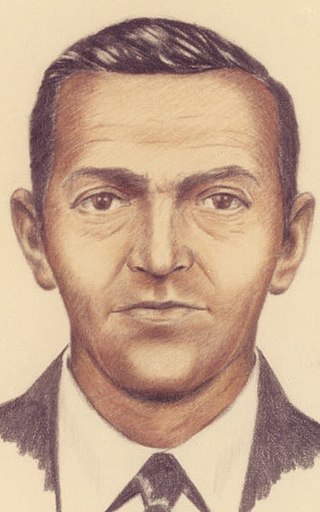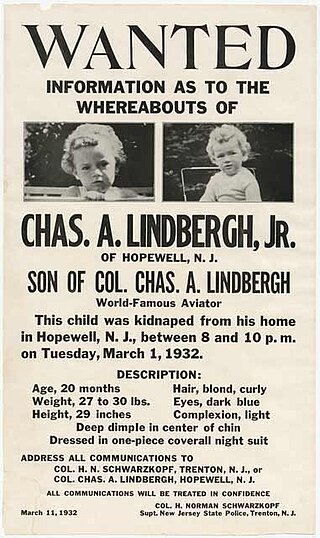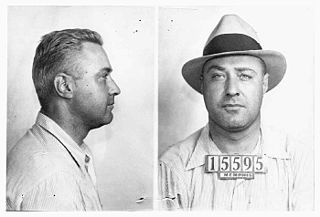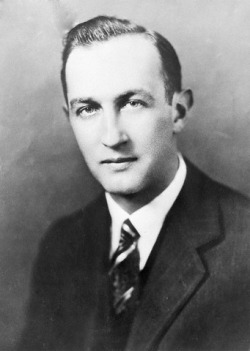
D. B. Cooper is a media epithet for an unidentified man who hijacked Northwest Orient Airlines Flight 305, a Boeing 727 aircraft, in United States airspace on November 24, 1971. During the flight from Portland, Oregon, to Seattle, Washington, the hijacker told a flight attendant he was armed with a bomb, demanded $200,000 in ransom and requested four parachutes upon landing in Seattle. After releasing the passengers in Seattle, the hijacker instructed the flight crew to refuel the aircraft and begin a second flight to Mexico City, with a refueling stop in Reno, Nevada. About 30 minutes after taking off from Seattle, the hijacker opened the aircraft's aft door, deployed the staircase, and parachuted into the night over southwestern Washington. The hijacker has never been found or conclusively identified.

Bruno Richard Hauptmann was a German-born carpenter who was convicted of the abduction and murder of the 20-month-old son of aviator Charles Lindbergh and his wife Anne Morrow Lindbergh. The Lindbergh kidnapping became known as "The Crime of the Century". Both Hauptmann and his wife, Anna Hauptmann, proclaimed his innocence to his death, when he was executed in 1936 by electric chair at the Trenton State Prison.

On March 1, 1932, Charles Augustus Lindbergh Jr., the 20-month-old son of colonel Charles Lindbergh and his wife Anne Morrow Lindbergh, was abducted from his crib in the upper floor of the Lindberghs' home, Highfields, in East Amwell, New Jersey, United States. On May 12, the child's corpse was discovered by a truck driver by the side of a nearby road.

Kate Barker, better known as Ma Barker, was the mother of several American criminals who ran the Barker–Karpis Gang during the "public enemy era" when the exploits of gangs of criminals in the Midwestern United States gripped the American people and press. She traveled with her sons during their criminal careers.

Ransom is a 1996 American action thriller film directed by Ron Howard from a screenplay by Richard Price and Alexander Ignon. The film stars Mel Gibson, Rene Russo, Gary Sinise, Delroy Lindo, Lili Taylor, Brawley Nolte, Liev Schreiber, Donnie Wahlberg and Evan Handler. Gibson was nominated for a Golden Globe Award for Best Actor. The film was the 5th highest-grossing film of 1996 in the United States. The original story came from a 1954 episode of The United States Steel Hour titled "Fearful Decision". In 1956, it was adapted by Cyril Hume and Richard Maibaum into the feature film, Ransom!, starring Glenn Ford, Donna Reed, and Leslie Nielsen.

Alvin Francis Karpis, was a Canadian–American criminal of Lithuanian descent known for being a leader of the Barker–Karpis gang in the 1930s. Nicknamed "Creepy" for his sinister smile and called "Ray" by his gang members, Karpis led the gang along with Fred Barker and Arthur "Doc" Barker. There were only four "public enemies" ever given the title of "Public Enemy #1" by the FBI and he was the only one to be taken alive. The other three, John Dillinger, Pretty Boy Floyd, and Baby Face Nelson, were all killed before being captured. He also spent the longest time as a federal prisoner at Alcatraz Federal Penitentiary, serving twenty-six years.

George Kelly Barnes, better known by his pseudonym "Machine Gun Kelly", was an American gangster from Memphis, Tennessee, active during the Prohibition era. His nickname came from his favorite weapon, a Thompson submachine gun. He is best known for the kidnapping of oil tycoon and businessman Charles F. Urschel in July 1933, from which he and his gang collected a $200,000 ransom. Urschel had collected and left considerable evidence that assisted the subsequent FBI investigation, which eventually led to Kelly's arrest in Memphis on September 26, 1933. His crimes also included bootlegging and armed robbery.

Robert Cosgrove Greenlease Jr. was a six-year-old from Kansas City, Missouri, United States, who was the victim of a kidnapping and homicide on September 28, 1953. His father, Robert Cosgrove Greenlease Sr., was a multi-millionaire auto dealer, and the demanded ransom payment was the largest in American history at the time.

The Negotiator is a crime novel by English writer Frederick Forsyth, first published in 1989. The story includes a number of threads that are slowly woven together. The central thread concerns a kidnapping that turns into a murder and the negotiator's attempts to solve the crime.

Roger Touhy was an Irish American mob boss and prohibition-era bootlegger from Chicago, Illinois, in the United States. He is best remembered for having been framed by his rivals in Chicago organized crime for the fake 1933 kidnapping of Jewish-American organized crime figure and Chicago Outfit associate John "Jake the Barber" Factor, a brother of cosmetics manufacturer Max Factor Sr.. Despite numerous appeals and at least one Federal court ruling freeing him, Touhy spent 26 years in prison until he was finally exonerated and released in November 1959. In retaliation for filing a lawsuit against acting boss Tony Accardo and other senior Mafiosi, Touhy was murdered in an alleged contract killing by the Chicago Outfit less than a month after his release.
Arthur Seale, of Hillside, New Jersey, and his wife Irene were responsible for the kidnapping and murder of Sidney Reso, the Vice President of International Operations for Exxon on April 29, 1992, in Morris Township, New Jersey. The case garnered national notoriety.

Arthur Raymond "Doc" Barker was an American criminal, the son of Ma Barker and a member of the Barker-Karpis gang, founded by his brother Fred Barker and Alvin Karpis. Barker was typically called on for violent action, while Fred and Karpis planned the gang's crimes. He was arrested and convicted of kidnapping in 1935. Sent to Alcatraz Federal Penitentiary in 1936, he was killed three years later while attempting to escape.

Basil Hugh "The Owl" Banghart Jr. was an American criminal, burglar, and prison escape artist. Although a successful "stickup artist" during the 1920s and early 1930s, he is best remembered for his involvement in the hoax kidnapping of Chicago mobster Jake "the Barber" Factor, a crime for which Roger Touhy and he were eventually proven innocent after nearly 20 years in prison.

Frederick George Barker was an American criminal who, along with Alvin Karpis, co-founded the Barker-Karpis gang, which committed numerous robberies, murders and kidnappings during the 1930s. Barker was the youngest son of Ma Barker, all of whose children were criminals. He was killed in a lengthy gunfight with the Federal Bureau of Investigation (FBI) in 1935.
Crime rates in the state of Washington grew rapidly to large levels from 1960 to 1980, however slowed in growth from 1980 onward. Although the cause of this drop in crime growth from the 1980s cannot be directly determined, it was believed to have been a result from several law enforcement initiatives & policies implemented throughout the state of Washington and across the United States, such as abortion access.

The kidnapping of Edward Bremer was the last major criminal enterprise of the Barker-Karpis gang. Though successful in netting the gang a large ransom, it brought down the full force of the FBI on the gang, resulting in the death or capture of its main members in the months afterwards. The kidnapping was ordered by St. Paul Jewish-American organized crime boss Harry Sawyer, and carried out by Fred Barker, Alvin Karpis, Arthur Barker, Volney Davis and Chicago Outfit mobster George Ziegler.

Show Them No Mercy! is a 1935 American crime film directed by George Marshall and written by Kubec Glasmon and Henry Lehrman. The film stars Rochelle Hudson, Cesar Romero, Bruce Cabot, Edward Norris, Edward Brophy and Warren Hymer. The film was released on December 6, 1935, by 20th Century Fox.

The apparent success and instant notoriety of the hijacker known as D. B. Cooper in November 1971 resulted in over a dozen copycat hijackings within the next year all using a similar template to that established by Cooper. Like Cooper, the plan would be to hijack an aircraft, demand a ransom, and then parachute from that aircraft as a method of escape. To combat this wave of extortion hijackings, aircraft were fitted with eponymous "Cooper Vanes," specifically designed to prevent the aft staircase from being lowered in-flight. The Cooper Vane, as well as the widespread implementation of other safety measures such as the installation of metal detectors throughout American airports, would spell the end of the Cooper copycats.
In 1975, Samuel Bronfman II, the 21-year-old heir to the Bronfman family trust then worth $750 million, was kidnapped after a gathering in Yorktown Heights, New York, and held for ransom. His kidnappers were caught and the ransom recovered, but the defendants' attorneys mounted a defense that argued Bronfman had been a co-conspirator, and the abductors were only convicted of extortion, not kidnapping. The defense attorney confessed in 2020 that he had been aware the defense was a lie and that Bronfman had been an innocent victim.
The kidnapping of Howard Woolverton, which began in South Bend, Indiana, the evening of January 26, 1932, and concluded when Woolverton returned to his home unharmed about 24 hours later, received extensive contemporary newspaper coverage, impacted the way the press covered kidnapping in the following weeks, and played a leading role in passage of the Federal Kidnapping Act later that year.

















